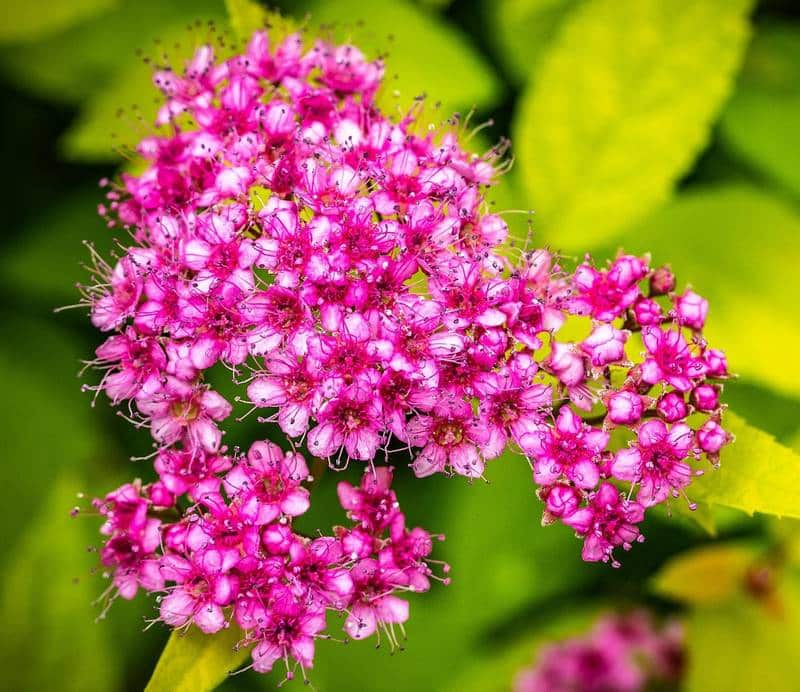Is Spirea Toxic to Dogs? Is Spirea Poisonous to Dogs?
Is spirea toxic to dogs? Is spirea poisonous to dogs? In this article, we’ll explain everything you need to know about if spirea is safe for dogs, including what to do if your dog ate spirea already. We’ll then teach you the two commands that will ensure your dog behaves around spirea and other bushes that might be toxic.
Next, we’ll cover more you should know about spirea and dogs, such as how to keep dogs away from spirea using barriers. Finally, we’ll instruct you on how to properly care for the spirea plant (varieties, pruning, fertilizer, sun or shade, winter care, height, growth speed, lifespan) and more to know when you have dogs. Keep reading!
Is Spirea Toxic to Dogs?

Spirea is not toxic to dogs. Unlike some other common garden plants, spirea poses no immediate threat if ingested by your furry friend. However, it’s always wise to train your dog to avoid munching on any plants to prevent gastrointestinal upset or choking hazards.
Is Spirea Poisonous to Dogs?
Spirea is not poisonous to dogs. That said, it’s still crucial to observe any changes in your dog’s behavior after they’ve come into contact with spirea, as excessive consumption of any plant can lead to minor digestive issues.
Train the “Leave It” Command
- Choose a treat that your dog loves and let them see it.
- Close your fist around the treat and say “Leave it.”
- Wait until your dog stops sniffing or pawing at your hand.
- When they pull away, say “Yes” or “Good” and offer the treat.
- Practice this command regularly to instill the habit.
Training your furry friend to follow the “Leave It” command can be a life-saver, even if spirea is not toxic to dogs. It teaches them to avoid potentially harmful situations, not just with plants but also in various other contexts.
Train the “Drop It” Command
- Start with a toy your dog likes but isn’t too attached to.
- Engage in play, and then say “Drop it” while showing a treat.
- Once your dog releases the toy, offer the treat and plenty of praise.
- Repeat the process multiple times to reinforce the command.
- Over time, make it more challenging by using higher-value toys or situations.
The “Drop It” command is another important tool because it gives you one last chance to get your dog to release something before swallowing it.
While spirea is not poisonous to dogs, implementing basic training commands like “Leave It” and “Drop It” adds an extra layer of security. It’s important to remember, however, that the underlying behavioral issues (curiosity, anxiety, boredom, etc.) that were causing all of this to begin with will still be present.
And until you address those, any positive changes you see are only going to be temporary.
“Well, how do I make these changes last?”
By getting your dog to truly choose to follow your direction, that’s how. I tried many times to write out how you can do that before deciding it made more sense to just link you to the free video series that explains it better than I’d ever be able to.
The series is by a man named Dan who is one of the world’s leading dog obedience trainers. In it, he teaches you how to put an end to things like your dog getting too close to spirea and all other misbehavior using his fast and easy-to-follow methods.
In the first video, Dan will reveal to you why the two most common methods of dog training only doom you to failure. You can watch the video now by clicking here. Follow the proven system he’ll show you in his series and you’ll never have to spend another second worrying about your dog eating spirea ever again!
Is Spirea Safe for Dogs?

Spirea is safe for dogs. If your dog happens to munch on some spirea leaves or flowers, there’s generally no need for immediate concern. Nevertheless, knowing how to manage and prevent your dog’s interaction with the plant can offer peace of mind.
Dog Ate Spirea, What Do I Do?
If your dog ate spirea, there’s usually no need for panic. Observe your pet for signs of gastrointestinal upset, such as vomiting or diarrhea, which might occur from eating any plant material in excess. If symptoms persist, consult your veterinarian.
Dog Eating Spirea: How to Prevent
Preventing your dog from eating spirea involves some simple measures. You can create a physical barrier around the plant, use dog repellent sprays, or employ training commands like “Leave It” to deter your pet from approaching the spirea. Learn it now in the first section.
What Attracts Dogs to Spirea?
While spirea itself doesn’t contain any elements that specifically attract dogs, canines are naturally curious creatures. They might be drawn to the plant’s scent, the movement of its leaves in the wind, or simply the opportunity to explore a new item in their environment.
In summary, spirea is safe for dogs, but it’s always a good practice to prevent your pet from eating non-food plants. Familiarize yourself with basic first aid steps if your dog does ingest spirea and consider implementing preventive measures to maintain a dog-friendly garden.
Make sure to get this all addressed now, as it will also keep your dog safe around other plants. You then won’t even have to think about things like are pothos toxic to dogs, is Weigela poisonous to dogs, are rhododendrons poisonous to dogs, or are azaleas toxic to dogs.
Spirea and Dogs

Spirea and dogs can safely coexist, making it a nice choice for pet owners who also love gardening. However, since it’s not ideal for dogs to eat non-food plants, taking some preventive steps to manage your pet’s interaction with spirea is still a good idea.
How to Keep Dogs Away From Spirea
Keeping dogs away from spirea can be successfully achieved through several means, which can be adapted based on your garden’s layout and your dog’s behavior.
One of the most effective methods is installing physical barriers such as small fences or garden netting around the plants. This not only prevents your dog from reaching the spirea but also helps keep other animals out.
Another option to consider is the use of dog-safe repellent sprays. These sprays can be applied on and around the spirea bushes to deter your pet from approaching, sniffing, or tasting the plants.
Dog-Safe Alternatives to Spirea
For pet owners looking for safe and visually appealing alternatives to spirea, several options are available. Plants like marigolds, snapdragons, or sunflowers not only add significant visual appeal to your garden but are also non-toxic to dogs.
These alternatives can provide you with peace of mind, ensuring that you have a beautiful garden that’s also safe for your four-legged family member. Teaching commands like “Leave It” and “Drop It” is still a good idea to ensure their safety, however. You can learn both now in the first section.
Spirea Varieties and Dog Safety
While spirea is safe for dogs, it’s important to note that there are multiple varieties of this shrub. Each variety has its own growth pattern, flower color, and foliage. While they are not toxic, some varieties may be more appealing to dogs than others due to their scent or appearance. Therefore, choosing a variety that is less enticing to dogs could be another layer of precaution to consider.
In summary, spirea is not harmful for dogs, but it’s wise to take preventive measures to ensure your dog doesn’t ingest it. You might also want to consider incorporating dog-safe plants into your garden as a further precaution.
Spirea Plant Care

Spirea plants are easy to care for, requiring basic maintenance such as regular watering, occasional pruning, and fertilizer application. They’re also adaptable to various soil types and light conditions, making them a suitable choice for gardeners who are also dog owners.
Caring for Spirea
Caring for spirea is relatively straightforward. These shrubs need well-drained soil and moderate watering. Overwatering should be avoided, as it can lead to root rot. Regular inspection for pests like aphids is also advised for keeping your spirea healthy.
Spirea Varieties
There are numerous varieties of spirea, ranging from the white-flowered ‘Bridal Wreath’ to the pink ‘Little Princess.’ Each variety has its own specific care needs, although most are very forgiving and adaptable. The best part is that none of the spirea varieties are known to be toxic to dogs, making them a worry-free choice for pet owners.
Spirea Pruning
Pruning is an essential aspect of spirea care. For most varieties, the best time to prune is late winter or early spring, just before new growth starts. Pruning helps maintain the shrub’s shape and promotes healthy growth. Always use clean, sharp tools to avoid transmitting diseases.
Spirea Fertilizer
Fertilizing your spirea is another important care step. Use a balanced, all-purpose fertilizer in the spring. Some gardeners also prefer to add a second application in late summer to support fall blooming. Make sure to follow the manufacturer’s instructions for application rates.
Spirea: Sun or Shade?
Spirea plants generally prefer full sun to partial shade. However, they’re quite adaptable and can tolerate less-than-ideal light conditions. Just remember, too little light can lead to fewer blooms and a less dense plant.
Spirea in Winter
In colder climates, spirea shrubs can benefit from some winter protection. Mulching around the base can help retain moisture and regulate soil temperature. This can be especially useful in preventing freeze-thaw cycles that might otherwise damage the roots.
Spirea Height
The height of a spirea shrub largely depends on its variety. Some can be as small as 2 feet while others can grow up to 8 feet tall. Always check the specific variety’s details before planting to ensure it fits within your landscaping plans.
How Fast Do Spirea Grow?
Spirea shrubs are relatively fast-growing, especially when planted in optimal conditions. You can expect most varieties to reach their mature size within a few years, making them an excellent choice for gardeners looking for quick results.
How Long Do Spirea Bushes Live?
Spirea bushes are quite hardy and can live for several decades if properly cared for. Their longevity makes them a worthwhile investment for your garden, and their general safety for dogs adds to their appeal.
In summary, spirea is a low-maintenance, dog-safe plant that offers great versatility and beauty for your garden. With just a little care, these shrubs can thrive for many years, adding both visual appeal and peace of mind for dog owners.
To ensure your dog’s safety around plants of all types, teach them the “Leave It” and “Drop It” commands. You can learn both now in the first section.
You’re probably ready to get started on things now that you’ve got all of your questions about spirea and dogs answered, so I’ll let you begin. Good luck, and thanks for reading our article “Is Spirea Toxic to Dogs? Is Spirea Poisonous to Dogs?”





